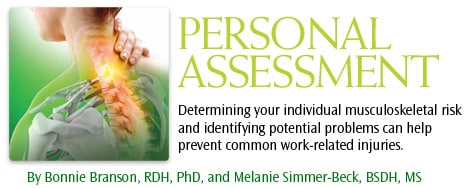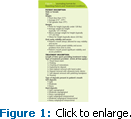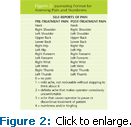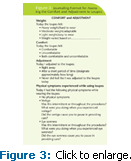
Personal Assessment
Determining your individual musculoskeletal risk and identifying potential problems can help prevent common work-related injuries.

Musculoskeletal disorders of the hands and wrist cause symptoms such as pain, tingling, and numbness due to the physical stress of performing dental procedures.13 Numbness and tingling are symptoms of carpal tunnel syndrome.14 Symptoms of upper extremity injury include stiffness, tenderness, radiating pain between the shoulders, and frequent headaches.15
WMSDs result in a loss of income, increase of medical expenses, increase in workers’ compensation claims, and often result in higher levels of difficulty completing daily tasks. The pain from WMSDs causes absences from work, a decrease in number of days worked, or even a career change. Many dental hygienists decrease work hours due to WMSDs.2,16
Poor working posture is a significant contributor and is mainly caused by excessive head tilt and awkward movement of the back and twisting of the body in order to see more effectively.17
DEVELOPING A PERSONAL ERGONOMIC ASSESSMENT PLAN
Dental professionals need to develop a personal plan for assessing their individual musculoskeletal risk and identify problems that exist. The dental office environment offers little time or opportunity to measure posture and hand pain. However, with a few adjustments to the work routine, the clinician can gain an awareness of the specific overall problems that are occurring throughout the workday. Self-reports and direct observations of posture can be effectively used in the dental office. Self-reports involve focused journaling and self-analysis of pain perceptions experienced throughout the workday. These are simple and easily managed by the clinician.
Focused journaling requires dental professionals to keep a record of their posture and pain experienced over time. Figures 1-4 provide examples of journal formats that can be adapted to fit dental professionals’ personal needs.
Each journal format directs the dental professional to describe various parameters that may play a part in musculoskeletal health.18 Figure 1 is a journal format used to document the type of patient and treatment conditions encountered during the dental appointment. The patient’s overall body type is described as well as the visibility and access to the oral cavity. Furthermore, the type and length of treatment provided and the level of difficulty of patient conditions are noted. Figure 2 is a journaling format used to report pain and numbness both before and after treatment. Records such as this can provide a chronicle of data that helps determine what patient and work conditions result in WMSD issues. These journal formats should be used any time dental professionals are assessing WMSDs and associated interventions such as loupes, co-axial illumination, or changes in instrument selection.
Figures 3 and 4 are journal formats that can be used when loupes are introduced into the workday. These formats keep a record of the clinician’s perceptions of the impact of loupes on the work experience. The format of Figures 3 and 4 addresses comfort of loupes, adjustment issues, and the clinician’s perceptions of impact on skills and posture. These reports can be combined with the pain/numbness report (Figure 2) to chronicle any WMSD experienced while using loupes. The clinician can make decisions regarding the value of loupes with a series of journals made before and after the initiation of loupes.
Direct observations may be needed to objectively evaluate posture as part of the personal ergonomic assessment. These observations require another member of the dental office staff to measure the posture of the dental hygiene clinician. This second party needs to use a reliable posture assessment instrument, like Branson’s Posture Assessment Instrument (BPAI).19 The BPAI (Table 1) outlines validated parameters of posture components that are observed over a 5-minute time period. Throughout the workday, the observer performs periodic 5-minute assessments of the dental professional’s posture. The time required for this is minimal and can be done unobtrusively without interrupting patient care.
The evaluator observes the posture for 1 minute and then scores the clinician during the second minute. The evaluator observes the clinician during the third minute and records a score during the fourth minute. The evaluator completes the observation over the fifth minute and then makes the final marks. The addition of all the points scored provides a total for each observation. Scores that range between 30 and 59 are considered acceptable. Scores between 60 and 78 are in the compromised category and scores of 79 or greater place the clinician in a harmful category. Conducting this evaluation throughout the day provides the clinician with an observer’s rating of posture. Clinicians can then determine if their posture changes based on the time of day, type of treatment provided, or the patient’s size and ease of access to the oral cavity.
REFERENCES
- Morse T, Bruneau H, Michaluk-Turcotte C, et al. Musculoskeletal disorders of the neck and shoulder in dental hygienists and dental hygiene students. J Dent Hyg. 2007;81:10.
- Yee T, Crawford L, Harber P. Work environment of dental hygienists. J Occup Environ Med. 2005;47:633-639.
- Crawford L, Gutierrez G, Harber P. Work environment and occupational health of dental hygienists: a qualitative assessment. J Occup Environ Med. 2005;47:623-632.
- Morse T, Michaluk-Turcotte C, Sanders M, et al. Musculoskeletal disorders of the neck and shoulder in dental hygienists and dental hygiene students. J Dent Hyg. 2003; 77:173-179.
- Werner RA, Hamann C, Franzblau A, Rodgers PA. Prevalence of carpal tunnel syndrome and upper extremity tendinitis among dental hygienists. J Dent Hyg. 2002;76:126-32.
- Anton D, Rosecrane J, Merlino L, Cook T. Prevalence of musculoskeletal symptoms and carpal tunnel syndrome among dental hygienists. Am J of Ind Med. 2002; 42:248-257.
- Lalumandier JA, McPhee SD. Prevalence and risk factors of hand problems and carpal tunnel syndrome among dental hygienists. J Dent Hyg. 2001;75:130-34.
- Rolander B, Bellner AL. Experience of musculo-skeletal disorders, intensity of pain, and general conditions in work—the case of employees in non-private dental clinics in a county in southern Sweden. Work. 2001;17:65-73.
- Shenkar O, Mann J, Shevach A, Ever-Hadani P, Weiss P. Prevalence and risk factors of upper extremity cumulative trauma disorder in dental hygienists. Work. 1998; 11:263-275.
- Special Report. Bureau of Labor Statistics, United States Department of Labor: Washington, DC; June 28, 2004.
- Liss GM, Jesin E, Kusiak RA, White P. Musculoskeletal problems among Ontario dental hygienists. Am J Ind Med. 1995;28:521-540.
- Rice VJ, Nindl B, Pentikis JS. Dental workers, musculoskeletal cumulative trauma, and carpal tunnel syndrome: who is at risk? a pilot study. Int J Occup Saf and Ergon. 1996;2:218-233.
- Michalak-Turcotte C. Controlling dental hygiene work-related musculoskeletal disorders: the ergonomic process. J Dent Hyg. 2000; 74:41-48.
- You H, Simmons Z, Freivalds A, Kothari MJ, Naidu SJ. Relationships between clinical symptom severity scales and nerve conduction measure in carpal tunnel syndrome. Muscle Nerve. 1999;22:497-501.
- Valachi B. Managing muscles: neck and shoulder pain among dental hygienists. Contemporary Oral Hygiene. 2004;4:8-14.
- Morse TF, Dillon C, Warren N, Levenstein C, Warren A. The economic and social consequences of work-related musculoskeletal disorders: the Connecticut Upper- Extremity Surveillance Project (CUSP). Int J Occup Environ Health. 1998;4:209-216.
- Chang BJ. Ergonomic benefits of surgical telescope systems: selection guidelines. J Calif Dent Assoc. 2002;30:161-169.
- Liskiewicz ST, Kerschbaum WE. Cummulative trauma disorders: an ergonomic approach for prevention. J Dent Hyg. 1997;71:162-167.
- Valachi B. Taking dental ergonomics to a new level: avoiding the ten common mistakes dental hygienists make. Contemporary Dent Hygiene. 2005;5:8-14.
From Dimensions of Dental Hygiene. April 2009; 7(4): 20-23.



